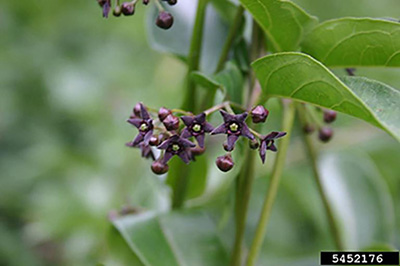By Casey Hull
Capital News Service

Black swallow-wort. Image: Leslie Mehrhoff, University of Connecticut
A new invasive species management plan may help Michigan agencies combat intrusive plants — and rescue wildlife at risk.
That’s good news for the monarch butterfly which has declined in numbers and lost its habitat because of the black swallow-wort. The invasive vine displaces milkweed, the butterfly’s source of food. It is also poisonous to monarch caterpillars.
The vine grows predominantly in Southern Michigan. It has been also reported in a couple of counties in the northern Lower Peninsula and one in the Upper Peninsula. Experts fear it’s spread.
“Invasive plant species in Michigan generally start in Southern Michigan and hitchhike up into Northern Michigan by way of people or being spread by wind,” said Sue Tangora, the Department of Natural Resources (DNR) forest health and cooperative programs section supervisor.
The World Wildlife Fund of Mexico reports that the monarch population has decreased by 15 percent in the past year.
After their winter migration to Mexico, monarchs are more densely clustered, making it easier to count them. In summer, they spread across most of the eastern United States with the majority located from South Dakota to eastern Connecticut.
A group of Midwestern nonprofit and government groups met twice in 2016 in Michigan to plan how to help the butterflies recover, said Mike Parker, of the DNR’s wildlife division.
The pillars of the plan are “habitat conservation, education and outreach, monitoring and research, policy review and promoting collaborative partnerships,” said Parker, the divisions conservation partners specialist.
Creating a sustainable grassland habitat for monarchs requires milkweed and wildflowers.

Monarch on milkweed. Image: Michigan State University Extension.
“Milkweed is the only plant that monarch caterpillars will eat, but adult monarchs eat the nectar that wildflowers provide,” Parker said. “It’s essentially the carbohydrates they need to make their 2,000 mile journey back to Mexico.”
Grasslands are a natural ecosystem for milkweed and wildflowers, but invasive species can overtake a natural ecosystem if there’s nothing there to eat them.
“There are a lot of invasive species that impact grasslands, but the black swallow-wort is probably the most concerning at this point,” Parker said.
Michigan’s Terrestrial Invasive Species State Management Plan is a partnership among the DNR and departments of Agriculture & Rural Development and Environmental Quality.
The plan outlines the need to collaborate to quickly prevent, detect and remove new species early.
Black swallow-wort grows quickly and is toxic to both caterpillars and mammals. It produces seed pods similar to milkweed seed pods, said the DNR’s Tangora.
And monarchs lay eggs on the black swallow-wort.
“Unlike milkweeds, swallow-wort does not provide the same nutrition for caterpillars that milkweed does,” Tangora said.“The eggs hatch, but they are unable to feed on the black swallow-wort and don’t survive.”
Swallow-worts also push out indigenous milkweed, removing habitat for monarchs to lay eggs. “Any place where you have swallow-wort, it has a tendency to dominate that system,” Tangora said.
She said a combination of herbicides and plucking seed pods before they open is the best way to control its spread.
Regional cooperative invasive species management areas are working to prevent the spread of invasive species.
“We’ve been lucky that we haven’t found any black swallow-wort in this area,” said Vicki Sawicki, the coordinator for the North County Cooperative Invasive Species Management Area which covers Lake, Mason, Mecosta, Missaukee, Osceola and Wexford counties.
“Right now we’re just getting the word out regarding what it looks like,” Sawicki said.
She believes it’s likely that black swallow-wort is in the area but hasn’t been spotted yet.
“I’ve seen it in fields from other areas and it’s very nondescript. If you don’t know what it looks like you’ll look right past.”
Black swallow-wort has also been reported in Delta, Grand Traverse, Emmet and Cheboygan counties, according to the Midwest Invasive Species Information Network and the University of Michigan Herbarium.
Tangora said the monarch isn’t on the endangered list but is a species of greatest conservation need. A species of greatest conservation need has low or declining populations and needs human intervention and sometimes legal protection.